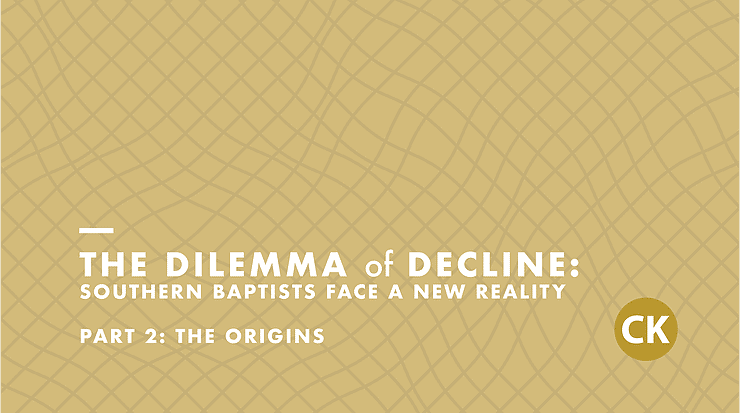By Dr. Chuck Kelley
The Southern Baptist story to date can be summarized in three words: growth, plateau, and decline. In 1845 in Augusta, GA, individual Baptist churches from across the South came together to form a Convention of churches that would hold two conflicting realities in permanent tension: true congregational autonomy for every church and deep missional cooperation to prepare ministers and fulfill the Great Commission. After the ravages of the Civil War, Southern Baptists grew steadily until World War II. After World War II, the growth became explosive, driven by aggressive evangelism and even more aggressive discipleship, making Southern Baptists the largest Protestant denomination in the United States.
The growth began slowing in the sixties, although baptism numbers did not peak until the Jesus Movement in the early seventies. In spite of the Jesus Movement spike, the period of plateau had begun for Southern Baptists, and from that point the statistics began to flatten out. The numbers moved up and down, but the peaks were lower and the valleys more frequent. The days of steady, continual growth were over.
I suggest the turning point from plateau to decline can be traced to the year 2000, when records indicate a new trend began: a steady increase in churches and a steady decrease in baptisms by those churches. As the following years unfolded, the decline in baptisms continued and then spread to other aspects of church life: membership, worship attendance, Sunday School/Bible Study attendance, and giving. A chart showing this is coming in Part 8. The Southern Baptist growth machine had fallen into a state of disrepair. What happened? Here are a few of my observations:
1) Demographic factors such as urbanization, immigration, globalization, and growing ethnic diversity reshaped the national population.
2) An increasingly diverse, pluralistic, entertainment-driven culture, given a relentless presence in the daily life of the nation by media and technology, began altering the worldview of many Southern Baptists, particularly among the young.
3) Carnalship, a desire to embrace both worldliness and worship became more prevalent than discipleship, as the pursuit of worldly experiences was judged more important than the pursuit of spiritual progress to a growing number of Baptists. Changes in typical wedding practices are a vivid example.
4) An important shift in the focus of the Convention publisher took root, from planning and sustaining a process of congregational discipleship in SBC churches through strategy, resource development, and training, to creating and selling a line of marketable faith-based products appealing to all evangelicals.
5) The growing influence of Reformed theology in Southern Baptist life diminished the passion and urgency driving Southern Baptist evangelism. Proponents began questioning many of the assumptions and practices that long characterized the evangelistic and missional approaches of Southern Baptists, paying less attention to baptism numbers as a marker of progress, and engaging less frequently in evangelistic activities. Growing tensions among those who were united in the Conservative Resurgence have been a result.
6) The fallout from unsettled leadership in the early years of the North American Mission Board and later, from the decision of NAMB to drop evangelism as a strategic priority and place an overwhelming emphasis on church planting, quieted the primary voice created to stimulate evangelism in Southern Baptist churches.
7) The disruptive effect of adjustments to the CP distribution process, particularly in the relationship between the state conventions and NAMB, deeply affected the evangelism network in the SBC and the fabric of cooperation.
The bottom line: the world began to do a more effective job of influencing SBC culture and drawing Southern Baptists out of their churches than Southern Baptists were doing of influencing American culture and drawing the worldly into their churches for salvation and discipleship. The problem was bigger than Southern Baptists not claiming new territory for the Gospel. They were not holding on to territory (and people) long thought secure.
Identifying the factors leading to decline is an interesting and complex discussion, but finding ways to address the reality of decline and create a path to fresh growth is the more important and pertinent discussion. At least five efforts to address the present evangelism crisis have been made at the Convention level since 2000. Were you aware of them? Those efforts and the impact those efforts have made to this point are the subjects of my next blogs.
Pastor’s Take Away: Decline can be triggered by circumstances beyond anyone’s control, by poor decisions, or by actions with unintended consequences. You can do the right things and still face the challenges of decline. Use decline as an opportunity to review the ministries of your church and ask: What area could most use a fresh approach? What need offers the best opportunity to start something new?




